Aluminium Design and Construction - Chapter 10 pps

Aluminium Design and Construction - Chapter 10 pps
... the same answer: Either (10. 9) or (10. 10) Expression (10. 9) is the one taught to students. Expression (10. 10) is more convenient for complex sections because a small design change to one element ... section. Figure 10. 15 shows an element LN forming part of the cross-section of such a member. The twist is assumed to be in a right-handed spiral (as in Figure 10. 7(a)), and the wa...
Ngày tải lên: 22/07/2014, 18:22
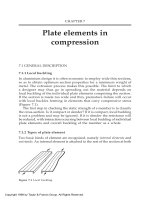
Aluminium Design and Construction - Chapter 7 pps
... element. Stress-pattern at failure, and assumed effective section. N=non-welded, W=with edge-welds. Figure 7.5 Slender outstand. Stress- pattern at failure, and assumed effective section. N=non-welded, ... outstands is similar, but with a different ß-scale (about one-third). The scatter shown in the figure results from random effects including initial out-of-flatness and shape of the st...
Ngày tải lên: 22/07/2014, 18:22
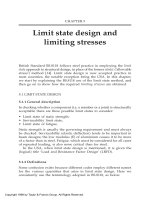
Aluminium Design and Construction - Chapter 5 pps
... appropriate scatter-band, with a cut-off at the limiting stress for the material. Local buckling of a thin-walled cross-section, as distinct from overall buckling of the member as a whole, is covered in Chapter ... All Rights Reserved. CHAPTER 5 Limit state design and limiting stresses British Standard BS.8118 follows steel practice in employing the limit state approach to structu...
Ngày tải lên: 22/07/2014, 18:22

Aluminium Design and Construction - Chapter 12 ppt
... axial stiffnesses of the bolt and the clamped plate material. Fisher and Struik suggest that for all-steel construction s lies in the range 0.05–0 .10. This tallies with a statement made in Part 10 of BS.5400: ... N=5 10 6 . There is then a transition line B of reverse gradient 1/(m+2) going from N=5 10 6 to 10 8 , followed by a (lower) horizontal cut-off. For any given class, th...
Ngày tải lên: 22/07/2014, 18:22

Aluminium Design and Construction - Chapter 11 docx
... time after mixing for 100 g of adhesive held at 25°C. 3. Columns 3 and 4 give the room temperature curing time to achieve =1 and =10 N/mm 2 , when tested at 23°C. 4. Columns 5 and 6 give typical ... parent metal, and k z1 = softening factor (Section 6.4.1). For the non-heat-treatable alloys it is found from: p f =0.5(f oo +f uo ) (11.18b) where f oo and f uo are the proof and...
Ngày tải lên: 22/07/2014, 18:22
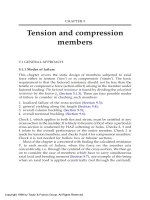
Aluminium Design and Construction - Chapter 9 docx
... shear centre S, H=warping factor, and l=effective buckling length. Here , Ip and H may be based on the gross section, and can be found with the aid of Chapter 10. The effective length l is less ... ‘Type-R’ sections In dealing with torsional buckling it is important to distinguish between ‘type-R’ sections and all others. A type-R section is one that consists entirely of radiating...
Ngày tải lên: 22/07/2014, 18:22
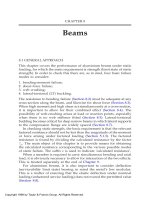
Aluminium Design and Construction - Chapter 8 doc
... yield stress and the 0.2% proof stress respectively for the two materials. Typically, the diagram might be looked on as comparing mild steel and 6082-T6 aluminium. Moment levels Zp ° and Sp ° ... elastic-perfectly plastic steel-type stress-strain curve. The effect, that the actual rounded nature of the stress-strain curve has on the moment capacity, is considered by Mazzolani in his...
Ngày tải lên: 22/07/2014, 18:22

Aluminium Design and Construction - Chapter 6 pptx
... material and also non-heat-treatable material there is negligible dip at A, and k z3 =k z1 . 6.4.2 Heat-treated material Table 6.1 lists proposed k z -values for MIG-welded joints in 6xxx and 7xxx-series ... non-heat-treatable alloys, HAZ softening need only be consid- ered for work-hardened material; it is not a factor with extrusions or Figure 6.2 Typical hardness plots at a weld in h...
Ngày tải lên: 22/07/2014, 18:22
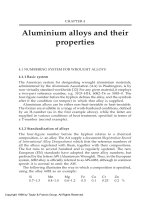
Aluminium Design and Construction - Chapter 4 pptx
... that alloy is supplied. Aluminium alloys can be either non-heat-treatable or heat-treatable. The former are available in a range of work-hardened conditions, defined by an H-number (as in the first ... of work-hardened sheet and drawn tube can be crudely expressed in terms of its hardness, the standard tempers being Table 4.1 The seven alloy series Note. NHT=non-heat-treatable, HT=heat-tr...
Ngày tải lên: 22/07/2014, 18:22
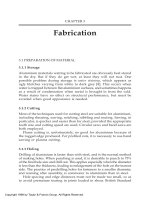
Aluminium Design and Construction - Chapter 3 potx
... for non-aeronautical use are usually in the stronger kind of 6xxx-series alloy. They can be either machined from T6-condition bar-stock, or forged and then artificially aged (T8-condition). Design data ... penny-pinching to select a bolt material that is less corrosion- resistant than the aluminium parts being connected. Aluminium and stainless steel are the preferred materials in t...
Ngày tải lên: 22/07/2014, 18:22
- design and construction of lpg installations
- api std 2510 design and construction of lpg installations
- api standard 2510 design and construction of lpg installations
- api std 2510 design and construction of liquefied petroleum gas installations lpg
- american petroleum institute api 2510 design and construction of lpg installations
- lord of the flies summary and analysis chapter 10
- code of practice for design and construction
- steel rigid frames manual design and construction